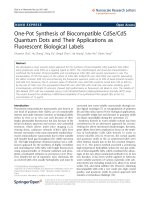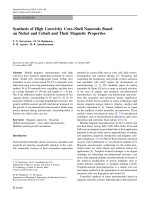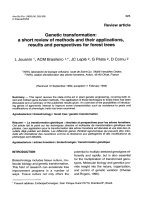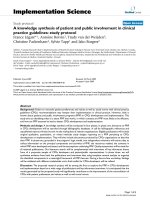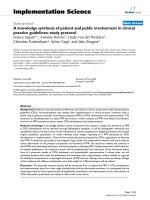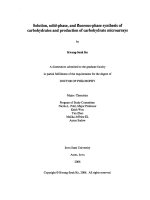Synthesis of cobalt and iron-based metal-organic frameworks and their applications
Bạn đang xem bản rút gọn của tài liệu. Xem và tải ngay bản đầy đủ của tài liệu tại đây (891.78 KB, 33 trang )
Vietnam National University - Ho Chi Minh City
University of Technology
THACH NGOC TU
SYNTHESIS OF COBALT AND IRON-BASED METALORGANIC FRAMEWORKS AND THEIR APPLICATIONS
Doctorate Thesis - The Summary
HO CHI MINH CITY, 2016
Abstract
The synthesis, structural identification of four novel cobalt and ironbased metal-organic frameworks (MOFs), named VNU-10 (cobalt-based
MOF), VNU-15 (iron-based MOF, VNU = Vietnam National University),
Fe-NH2-BDC and Fe-BTC have been done by single crystal x-ray
diffraction. Full characterization and application of VNU-10, VNU-15 were
undertaken, while preliminary characterizations have been done for FeNH2-BDC and Fe-BTC.
Accordingly, VNU-10 with 1.4 nm pore aperture and high surface area
(2600 m2 g-1) exhibited exceptional catalytic activity toward the direct
amination of bezoxazoles via CH/N-H couplings while a previously
reported topological isomer, Co2(BDC)2(DABCO)sql displayed poor
activity under testing condition. Leaching tests indicated that
homogeneous catalysis via leached active cobalt species is unlikely.
Furthermore, the VNU-10 catalyst was facilely isolated from the reaction
mixture and reused several times without degradation of the catalytic
reactivity.
Furthermore, VNU-15 with integrated sulphate ligands accompanied
by hydrogen-bonded dimethyl ammonium ions that lined the pore
channels, the proton conductivity of this material reached 2.90 × 10-2 S
cm-1 at 95 °C and 60% relative humidity which is roughly 2.5 times
higher than nafion under similar conditions (1.0 × 10-2 S cm-1 at 60%
RH and 80 °C) and on the order of a magnitude higher than that
observed in several of the highest performing MOFs reported, albeit
these materials’ proton conductivity properties were reported with
high working relative humidity (RH ≥ 90%). Remarkably, the ultrahigh
proton conductivity of VNU-15 was maintained under these
conditions, without any appreciable loss, for 40 hours.
2
Chapter 1: The Chemistry & Applications of Metal Organic
Frameworks
1.1 Definition of Metal organic frameworks (MOFs)
MOFs is the compound which are consisted of metal clusters and linker,
typically, polytopic organic carboxylates was employed, for example, 1,4benzenedicarboxylic acid (H2BDC), to construct two-, or three-dimensional
structures which can be porous (Figure 1).
Fig. 1 Structure of MOF-5 constructed from Zn4O(CO2)6 cluster and BDC2linker.
The High porosity of MOFs as well as the modular nature of MOF
design and synthesis, in which the backbone components [e.g.
inorganic and organic secondary building units (SBUs)], can be easily
tailored, MOFs is promised for diversified applications such as gas storage
and separation, catalysts, proton conduction, sensor, light harvest, drug
delivery, batteries and supercapacitors, and so on.
1.2 Applications of MOFs as Heterogeneous Catalysis
Catalysts, generally, were classified into homogenous and
heterogeneous, in which, the homogenous catalysts were recognized for fast
kinetic and high conversion in organic synthesis, albeit, several drawbacks
have been accounted for, which including the difficulties to separate the
catalysts for recycling investigations as well as desired products were
usually contaminated by catalyst or decomposed products of catalyst. On
the other hand, heterogeneous catalyst was recognized as greener pathway
for organic synthesis owning to its convenience for recycling, in which, the
catalysts can be easily separated from the reaction mixture. Despite
significant advantage of heterogeneous catalysts, organic synthesis
employed these catalysts, mostly resulted in low conversion, hence, one of
interesting research direction in the catalytic field has been devoted to
develop more efficiently heterogeneous catalysts.
Traditional heterogeneous catalysts include metal oxides, polymer resin,
silica gel and zeolites, for which, low surface area of metal oxides, polymer
resin as well as the small pore aperture of zeolite, preventing the large
organic substrates from reaching catalytic centers, thus limiting the use for
the transformation of large organic substrates. Another platform,
mesoporous silica gel, which possessed large pore and high surface area,
however, the structure and pore size of the materials are not uniform
and the immobilization of active centers within its pore has maintained
challenges.
Oxidative transformation of large organic substrates, commonly
required the formation of active radicals or high oxidation state of the
metal centers, which is unstable with very short decay time, hence
required fast diffusion of organic substrate onto the catalytic active sites.
Recently, MOFs have been employed as the platform for catalytic
synthesis of diverse organic compounds. In fact, most of published
MOFs possessed the small pore aperture with low surface area (less than
8 Å and 2000 m2 g-1), some of most noticeable MOFs have large internal
surface areas and ultralow densities.7 Due to the large and uniform pore
size and definitely coordinative environment of metal active centers, a
few MOFs catalysts exhibited interesting properties for oxidative
transformation of large organic substrates, however, the examples for these
class of catalytic reactions are still very rare.
1.3 Application of MOFs for Proton Conduction
The development of novel electrolyte materials for proton exchange membrane
fuel cells (PEMFCs) has received considerable attention owing to the need for
alternative energy technologies. However, effectively working condition of
PEMFCs was identified at medium temperature (T ≥ 100 °C) under low relative
humidity (RH), at which, higher CO tolerance of Pt catalyst was accounted for as
well as reducing the associating cost to maintain high RH at T ≥ 100 °C.
Unfortunately, the current technology, which utilized nafion proton conducting
membrane (the key components within HFCs) could not well support for above
working condition, hence, the quest to synthesize PEMFCs which can satisfactorily
function at medium temperature (T ≥ 100 °C) under low RH was raised as top
urgent goal.
Recently, metal-organic frameworks (MOFs) have been explored as
potential candidates for use as electrolyte materials. This is primarily due to
the modular nature of MOF design and synthesis, in which the backbone
components [e.g. inorganic and organic secondary building units (SBUs)] can
be easily tailored to satisfy particular applications. Indeed, previous work on
developing MOFs as proton conducting materials have focused on
incorporating proton transfer agents within the pores, functionalizing
coordinatively unsaturated metal sites, tuning the acidity of the pore channels
through incorporating specific functional groups and controlling and
modifying defect sites among others. These strategies have led to significant
developmental progress, in which proton conductivities in MOFs have been
achieved on the order of 10-2 S cm-1, but require high working relative humidity (≥
90% RH). On the other hand, proton conductivity under anhydrous conditions (T ≥
100 °C) in MOFs has reached ultrahigh levels (10-2 S cm-1), albeit in a limited
number of reports.
Table 1 Highest proton conductivity in MOFs.
Compounds
o / S cm-1
Ea / eV
UiO-66(SO3H)2
8.4 × 10-2
0.32
80
90
TfOH@MIL-101
8 × 10-2
0.18
60
15
CPM-103a
5.8 × 10-2
0.66
22.5
98
NA
25
98
{[(Me2NH2)3(SO4)]2[Zn2(
ox)3]}n
4.2 × 10
-2
T / °C RH / %
PCMOF10
3.5 × 10-2
0.4
70
95
VNU-15
2.9 × 10-2
0.22
95
60
2.2 × 10-2
0.14
80
95
2.1 × 10-2
0.21
85
90
2 × 10-2
1.1
130
0
1.0 × 10-2
0.42
150
0.13
H2SO4@Ni-MOF-74 (pH =
1.8)
PCMOF21/2
[ImH2][Cu(H2PO4)1.5(HP
O4)0.5·Cl0.5]n
H2SO4@MIL-101
Chapter 2: Synthesis of the Novel Metal-Organic Frameworks and
Characterizations
2.1 Introduction
The Quest of Novel MOFs with Enhanced Properties for Sustainable
Applications
The High porosity of MOFs as well as the modular nature of MOF
design and synthesis, in which the backbone components [e.g.
inorganic and organic secondary building units (SBUs)], can be easily
tailored, MOFs is promised for diversified applications such as gas storage
and separation, catalysts, proton conduction, sensor, light harvest, drug
delivery, batteries and supercapacitors, and so on.
Recently, more than 20.000 different MOFs have been reported. Several
of these were found to have the capabilities to solve challenge which
encountered in modern ages. Despite the significant progress in synthesis
and applications of MOFs, there are maintained challenges sought to
overcome by novel MOFs, which possess novel or enhanced properties,
for example, the quest to synthesize better proton conducting membrane
that can maintain high conductivity (>10-2 S cm-1) at medium temperature
(T ≥ 100 °C) or a demand for larger pore aperture porous material which
can serve as host scaffold for various doping of active guest molecules as
well as played the catalyst for the transformation of large organic
substrates.
In last two decades, a vast number of MOFs have been synthesized from
the cheap and commercial linkers, taken notices, our survey in Cambridge
structural database gave approximately 5092 structures, in which
terephthalic acid (H2BDC) was found to be the key constructed component.
However, in respecting to cheap cost for consequent vast production, in
scope of exploration, our targets employed the cheap and commercial
linkers as well as earth abundant metals such as iron and cobalt to
synthesize the novel metal-organic frameworks. Subsequently, our newly
discovered crystal structure were employed as standpoints for initially
justifying the interesting properties of novel MOFs in order to employ in
relevant applications.
Objective and Approach
During the last two decades, the huge number of MOFs have been
synthesized by several common organic building blocks, for examples, 1,4diazabicyclo[2.2.2]octane (DABCO); terephthalic acid (H2BDC); trimesic
acid (H3BTC); aminoterephthalic acid (NH2-H2BDC) and 1,6-naphthalene
dicarboxylic acid (H2NDC). In fact, there are maintained vast majority of
unexplored synthetic conditions, in which the mixture of several organic
building blocks, incorporating various metal sources, have been carried out
yet to synthesize metal-organic frameworks.
Hence, we employed single linker as well as the mixed linker strategy,
which incorporated with cobalt and iron metal sources to approach diverse
novel metal-organic frameworks which possess the enhanced or novel
properties, in which the new material can be utilized for relevant
applications.
2.2 Synthesis and characterization of VNU-10
2.2.1 Synthesis of VNU-10
In a typical synthesis procedure, a mixture of 1,4-benzenedicarboxylic
acid (H2BDC) (0.1 g, 0.60 mmol), 1,4-Diazabicyclo[2.2.2]octane (DABCO)
(0.075 g, 0.67 mmol), and Co(NO3)2·6H2O (0.1 g, 0.34 mmol) was
dissolved in a solvent mixture of N,N-dimethylformamide (DMF) (20 mL),
CH3COOH (2 mL, 0.01 mmol), and HCl (20 μL, 0.24 μmol). The resulting
solution was then dispensed equally to ten vials (10 mL). The vials were
heated at 120 °C in an isothermal oven for 12 h. After cooling the vials to
room temperature, the solid product was removed by decanting the
mother liquor and then washed with DMF (3 × 10 mL) to remove any
unreacted species. The DMF solvent was exchanged with dichloromethane
(DCM) (3 × 10 mL) at room temperature. The product was then dried at
120 °C for 4 h under vacuum, yielding green needle-shaped crystals of
VNU-10 (76% based on Co(NO3)2·6H2O) (Scheme 4). EA: Calcd. for
Co2C22H26O11N2 = [Co2(BDC)2(DABCO)]∙3H2O: C, 43.15; H, 4.28; N,
4.58%. Found: C, 43.19;
H, 4.35; N, 4.50%. AAS indicated cobalt amount of 20.0%, which matched
with calculated value of 20.9%.
Scheme 1 Synthetic scheme for crystallizing green, needle VNU-10.
2.2.2 Structure of novel Co2(BDC)2(DABCO)kgm
Novel cobalt MOF, named Co2(BDC)2(DABCO)kgm (VNU-10), has
been synthesized. Singe crystal X-ray diffraction revealed the large pore
aperture and high surface area of VNU-10 (14 Å pore window) (Figure 2).
Fig. 2 Structure of VNU-10, the paddle wheel cluster are connected with
BDC2- by two different way to form the DABCO connected kgm layers of
VNU-10 and DABCO connected sql layer of Co2(BDC)2(DABCO). C, black;
O, red; Co, light blue; N, blue; H was omitted for clarity.
2.2.3 Characterizations of VNU-10
Full characterization of VNU-10 has been done, which including single
and powder X-ray diffraction (SC-XRD and PXRD, respectively),
Elemental analysis (EA), Fourier transform infrared spectroscopy (FT-IR),
thermogravimetric analysis (TGA), atomic absorption spectroscopy (AAS),
inductively coupled plasma mass spectroscopy (ICP-MS) and gases
adsorption.
Fig. 3 N2 adsorption isotherm of VNU-10 at 77 K.
Among these analysis, and under the optimized activation condition, the
surface area of VNU-10 was measured by N2 adsorption at 77 K to be 2600
m2 g-1 (Figure 3).
2.3 Synthesis and characterization of VNU-15
2.3.1 Synthesis of VNU-15
A mixture of H2BDC (60 mg, 0.36 mmol), H2NDC (60 mg, 0.27 mmol),
9,10-anthraquinone (30 mg, 0.25 mmol), FeSO4·7H2O (60 mg, 0.143
mmol), and CuCl2·2H2O (60 mg, 0.345 mmol) were dissolved in 10 mL
DMF. The solution was sonicated for 10 min and then divided between six
borosilicate glass tubes (1.7 mL each tube). The glass tubes were
subsequently flame sealed under ambient conditions and placed in an
isothermal oven, preheated at 165 °C, for four days to yield reddish-yellow
crystals of VNU-15. These crystals were washed with 10 mL DMF (6
times) and immersed in DMF three days before exchanging the solvent
with 10 mL DCM over two days (6 times for exchanging solvent).
Thereafter, VNU-15 was activated at 100 °C to obtain 34 mg (0.051 mmol)
of dried VNU-15 (71.3% yield based on iron) (Scheme 5). Note: MIL-53
was formed in the absence of 9,10-anthraquinone to the reaction mixture.
Furthermore, MIL-88 was formed without CuCl2·2H2O added to the
reaction
mixture.
EA
of
activated
VNU-15:
Calcd.
for
Fe4C37.8H71.4N4.68O38.64S4
=
{[Fe4(NDC)(BDC)2DMA4.2(SO4)4]·0.4DMF}·10H2O: C, 29.38; H, 4.62; N,
4.25; S, 8.29%. Found: C, 28.95; H, 4.64; N, 4.74; S, 8.13%. Atomic
absorption spectroscopy (AAS) of activated VNU-15: 0.036 wt% copper.
Scheme 2 Synthetic scheme for crystallizing reddish-yellow, octahedral VNU-15.
2.3.2 Structure of Novel Anionic Fe-based metal-organic framework
Novel Anionic Fe-based metal-organic framework, termed VNU-15
(where VNU = Vietnam National University), has been synthesized.
Fig. 9 Crystal structure of VNU-15 is constructed from BDC2- and NDC2linkers
that
stitch
together
corrugated
infinite
rods
of [Fe2(CO2)3(SO4)2(DMA)2]∞ (a). These corrugated infinite rods propagate
along the a and b axes to form the three-dimensional architecture. The
structure is shown from the [110] and [001] plans (b, c, respectively).
Representation of the fob topology that VNU-15 adopts (d, e). Atom
colours: Fe, orange and blue polyhedra; C, black; O, red; S, yellow; N, blue;
and DMA cations, light blue. All other H atoms are omitted for clarity.
Single crystal X-ray diffraction (SCXRD) analysis revealed that
VNU-15 crystallized in the orthorhombic space group, Fddd (No. 70),
with unit cell parameters, a = 16.7581, b = 18.8268, and c = 38.9998
Å. The architecture of VNU-15 is based on two distinct linkers, namely
BDC2- and NDC2-, that stitch together corrugated iron infinite rod
SBUs.
These
infinite
rod
SBUs,
formulated
as
Fe2(CO2)3(SO4)2(DMA)2]∞, are composed of two independent
octahedral iron atoms that alternate consecutively in order (Figure 9a).
The coordination environment of each distinct iron atom is highlighted
by two equatorial corner-sharing vertices derived from μ2-O atoms of
the carboxylate functionality in NDC2-. It is noted that these μ2-O
atoms, which are cis to one another, are what promote the infinite rod
SBU to arrange in a corrugated fashion. The coordination sphere of
each iron is then completed through bridging axial sulphate ligands and
bridging carboxylate functionalities from BDC2- (Figure 9a). Two
BDC2- and one NDC2- linkers, relatively close together in space
(aromatic π–π interaction distance, 3.4 Å), connect infinite rods
together periodically in a perpendicular manner (83.4°) (Figure 9b and
9c). This propagates a three-dimensional architecture with the fob
topology (Figure 9d & e). We deduce that the π–π interactions played
an important role in forming the realized fob topological structure.
Finally, DMA counterions were found to line the infinite rod SBUs due
to hydrogen bonding with the axial bridging sulphate ligands (NH···O-S distances of 1.90 - 1.96 Å).
2.3.3 Characterizations of Novel Anionic Fe-based Metal-Organic
Framework
Full characterization of VNU-15, which including SC-XRD, EA,
PXRD, FT-IR, TGA, AAS, water and gases adsorption have been done.
Water isotherm of VNU-15 was measured by BELSORP-aqua3. VNU15 exhibited high water uptake at medium humidity (0.08 < P/P0 < 0.6),
the water uptake of VNU-15 are 102, 110 and 128 cm3 g-1 at P/P0 = 0.50,
0.55 and 0.60, respectively (Figure 10).
Fig. 10 Water uptake of VNU-15 at 25 °C as a function of P/P0 ranging from
8% to 80%. Inset: Water uptake of VNU-15 at 25 °C with P/P0 ranging from
8% to 62.58%.
2.4 Synthesis and characterization of Fe-NH2-BDC
2.4.1 Synthesis of Fe-NH2BDC
A mixture of NH2-H2BDC (0.13 g, 0.73 mmol), FeSO4·7H2O (0.13 g,
0.49 mmol), CuCl2·2H2O (0.13 g, 0.76 mmol), 9,10-anthraquinone (0.02 g,
0.095) were weighed in a bottle and DMF (15 ml) was added, thereafter,
the heterogeneous solution was sonicated 10 minutes to get the
homogeneously and transferred into three auto claves. The mixture was
heated in oven at 165
°C for 72 h. the resulting yellow square plate crystal of Fe-NH2BDC was
collected and washed with DMF (6 times). Fe-NH2BDC was exchanged
with dry DCM for 24 h (6 times) then heated at room temperature under
2 Fe-NH -BDC (0.102 g 56% yield
dynamic vacuum for 12 hours to obtain of
based on Fe). Note: without CuCl2·2H2O or 9,10-anthraquinone , MIL88B formed (Scheme 3).
Scheme 3 Synthetic scheme for reddish-yellow, blocked shape crystal of Fe-NH2BDC.
2.4.2 Crystal Structure of Fe-NH2BDC
Fig. 11 Structure of Fe-NH2BDC: a) Fe2(CO2)4(SO4)2 clusters were connected by
NH2-BDC to form Fe-NH2BDC; b) Connected sql layers through hydrogen bond
between (CH3)2NH2+ and sulphate ligand; c) Crystal structure of Fe-NH2BDC
represents in sql layers. Atom color: C, black; O, red; Fe, orange polyhedra; S,
yellow; N, blue; H of nitrogen, white; H atoms connected to carbon are omitted for
clarity.
The structure of Fe-NH2BDC was also solved by single crystal XRD,
which crystallized in I41/amd space group with the unit cell parameter a =
10.9546(8) Å, b = 10.9546(8) Å, c = 39.533(3) Å (Figure 11). Fe-NH2BDC
constructs from2- iron paddle wheel SBU with two apical sites are capped by
bi-dentate SO4 moieties, the paddle wheel SBUs are joined by NH2-BDC
linkers to expand as the sql layers (Figure 11a).2-Layers are further linked by
weak hydrogen bond between coordinated
and amino function of NH2SO4
BDC with N-H···OS
distances of 2.098 Å (Figure 34a), moreover, the two
2adjacent SO4 are bridged by DMA with N-H···OS distances of 2.148 Å to
form 2D structure (Figure 11b and c).
2.4.3 Characterizations of Fe-NH2BDC
Preliminary characterization of Fe-NH2BDC, which including SC-XRD,
PXRD, FT-IR, TGA have been done.
2.5 Synthesis and characterization of Fe-BTC
2.5.1 Synthesis of Fe-BTC
A mixture of H3BTC (0.106 g, 0.5 mmol), FeSO4·7H2O (0.067 g, 0.25
mmol), CuCl2·2H2O (0.06 g, 0.35 mmol), 9,10-Anthraquinone (0.02 g,
0.095 mmol) were weighed in a bottle and DMF (12 ml) was added,
thereafter, the heterogeneous mixture was sonicated 10 minutes to get
homogeneous solution and transferred into auto claves. The mixture was
heated in oven at 165 °C for 72 hours, the resulting reddish-yellow cube
crystal of Fe-BTC was collected and exchanged with DMF overnight (6
times). Thereafter, Fe- BTC was exchanged with dry DCM for 24 h (6
times) then heated at 100 °C under dynamic vacuum for 12 hours to obtain
activated Fe-BTC (0.06 g, 72% yield base on Fe) (Scheme 4).
Scheme 4 Synthetic scheme for reddish-yellow, blocked shape crystal of Fe-BTC.
2.5.2 Crystal Structure of Fe-BTC
The structure of Fe-BTC was identified by single crystal XRD, in which
Fe-BTC crystallized in P21212 space group (a = b = 19.29005, c = 12.67994
Å) (Figure 12). The structure of Fe-BTC was constructed from two different
kind SBU, which are the tetrahedral single iron atom SBU and the iron
paddle wheel SBU (Figure 12a). Two different kind SBUs in Fe-BTC linked
together by tri-angular BTC linker to expand into the mmm-a architecture
which consisted of small octahedron cage and large cuboctahedron cage,
which shared triangular face (Figure 12 b and c). The sulphate ligands were
found to cap apical sites of iron paddle wheel SBUs, another free chelate
oxygens of sulphate ligands were found to point toward space inside small
octahedron cage of mmm-a structure. Additionally,
DMA were attached to
2mmm-a net by hydrogen bond with SO4 moieties to occupy at the sharing
face of octahedron-cuboctahedron cage (Figure 12b)
Fig. 12 Crystal structure of Fe-BTC is constructed from BTC3- linkers and two
different SBU: tetrahedral single iron atom SBU and the iron paddle wheel SBU
(a); The crystal structure of Fe-BTC viewed along [001] plan (b); The mmm-a
topology of Fe-BTC (c). Atom colors: Fe, blue polyhedra; C, black. All other H
atoms are omitted for clarity. Atom colors: Fe, blue polyhedra; C, black; O, red; S,
yellow; N, blue; and DMA cations, light green. All other H atoms are omitted for
clarity.
2.5.3 Characterizations of Fe-BTC
Preliminary characterization of Fe-BTC, which including SCXRD, PXRD,
TGA have been done.
Chapter 3: Applications of VNU-10 and VNU-15
3.1 New Topological Co2(BDC)2(DABCO) As Highly Active Heterogeneous
Catalyst for Amination of Oxazoles via Oxidative C- H/N-H
Couplings
3.1.1 Introduction
The Quest for Large Pore Window (above 15 Å) and High Surface Area
(above 2600 m2 g-1) MOFs as Catalyst for Large Substrate Conversions
Recently, MOFs are employed as the platform for catalytic conversion
to achieve diversified organic compounds. Commonly, metal clusters played
the catalytic active sites in MOFs, on contrast, the active sites were
anchored into MOFs framework via the linkers before the selfassembly, post-
modification, or immobilized guest into the pore during self-assembly.
Consequently, small molecules is easy to enter pore of MOFs in order for
the reaction to be proceeded, however relative small pore size limited
catalytic conversion of large organic molecules which commonly
desired in pharmaceutical industry as the substrate cannot effectively
reaches the active sites which locate inside MOFs structure.
Indeed, the pore size of MOFs could be expanded by chose longer
linkers in an effort to produce larger pore structure with higher surface area.
On the contrast, the process had its own drawbacks, which belong to
complicated organic synthesis and the resulted structure usually
interpenetrated, that significantly reduced the pore size, additionally, larger
pore size potentially leaded to structure collapse under activated condition.
Large pore window and high surface area MOFs (above 14 Å, 2600 m2
g ) which constructed from cheap and commercially available linkers such
as
1,4-benzene
dicarboxylic
acid
(H2BDC)
and
1,4Diazabicyclo[2.2.2]octane (DABCO) are rare, in fact, only few MOFs
matched criteria, for examples, MIL-101, MIL-68, Zn2(BDC)2DABCOkgm,
and Ni2(BDC)2DABCOkgm,.
-1
Hence, the quest for designing and synthesizing large pore window and
high surface area MOFs from cheap linker and clarifying the advantages of
large pore size MOF compared with small pore size or nonporous material
on specific catalytic reactions for large substrates were raised.
Direct Amination of Azoles under Mild Reaction Conditions
Molecules containing aryl- and heteroarylamine moieties are frequently
found in a variety of biologically active natural products, polymers, as well
as functional materials. Traditional routes to access these molecules most
often employ nitrenoid chemistry. Since the pioneering work by Buchwald
and Hartwig, metal-mediated C-N bond formation directly from C-H bonds
have attracted an increasing amount of interest. To perform such
transformations, nitrogen moieties have been commonly installed by using
protected amines or hydroxylamine derivatives as starting materials. Simple
amine coupling partners employed in direct C-N bond formation of
unfunctionalized arenes or heterocyclic compounds have rarely been
reported. Typically, palladium and rhodium were exploited as catalysts for
these transformations, mostly in the intramolecular fashion.
Scheme 5 Plausible mechanism of direct amination of azoles.
The first method for copper-catalyzed directed amination of arene C-H
bonds was developed by the Yu group. Subsequent reports have
demonstrated ortho amination of 2-phenylpyridine derivatives through the
use of copper salts. Furthermore, Miura, Chang, and Schreiber
independently described procedures for deprotonative thiazole and oxazole
amination under copper catalysis. The first example of silver-mediated
benzoxazole amination by formamides or parent amines has also been
disclosed. Additionally, it was recently reported that cobalt and
manganese salts are catalytically active for the transformation. By
performing reactions under acidic conditions, Chang and co-workers were
able to direct oxidative amination of a variety of azoles in the presence
of a peroxide oxidant (Scheme 5). Despite the significant progress that
has been made toward developing highly active homogeneous catalysts,
the development of more economically and environmentally efficient
protocols, most notably by using heterogeneous catalytic systems, for this
transformation has yet to be reported.
Objective
Highlight the advantage of obtained cobalt based-MOF with the large
pore size and high surface area can be a highly active heterogeneous catalyst
for chemical transformation of large organic molecules which cannot be
done by smaller pore size MOFs.
Approach
Previously revealing in chapter 2, novel cobalt MOF, named
Co2(BDC)2(DABCO)kgm (VNU-10) has been synthesized, the structure was
identified to possess the large pore aperture and very high surface area (14
Å pore size, 2604 m2 g-1), the could be ideally to use for chemical
transformation of large organic molecules.
Scheme 6 Amination of Benzoxazole through N-H/CH bonds activation using
VNU-10 as catalyst.
Furthermore, we synthesize Co2(BDC)2(DABCO)sql (8 Å pore size,
1600 m2 g-1), which was constructed from the same structural components
(metal cluster, linkers, and coordinated bond types) with VNU-10
however the arrangement of constructed components are different in order
form different structure with smaller pore diameter (14 Å versus 8 Å).
Finally,
comparing
catalytic
performance
of
VNU-10,
Co2(BDC)2(DABCO)sql isomer, another MOFs, zeolites and oxide for
large organic substrates transformation (direct amination of azoles by
N-H/C-H bonds) in mild condition need to be done in order to claim
the importance of large channel diameter MOF (> 14 Å) as highly
active heterogeneous catalyst for large organic substrates
transformation while the smaller pore size MOFs could not proceed
the reaction (Scheme 6).
3.1.2 Catalytic Performance of VNU-10 for Amination of Benzoxazole
through N-H/C-H Bonds Activation
Under optimized conditions, 97% yield for amination of benzoxazole
was detected as VNU-10 was employed as catalyst. Controlled reaction
revealed that amination of benzoxazole via leaching of cobalt metal is
unlikely (Figure 13).
Fig. 13 Leaching test with catalyst removal during reaction course.
Conversion percentage as a function of reaction time in the presence of the
VNU-10 catalyst (filled circle) and once VNU-10 was removed 5 min after
the reaction started (open circle).
Comparing to other catalysts gave expected results, low conversion
(30%) was obtained as reported Co2(BDC)2(DABCO)sql was employed
while 97% yield for amination of benzoxazole was detected. Indeed, the
small pore size (8 Å) which limited the diffusion of reacted substrates.
Only 12% and 21% conversions were detected for Ni2(BDC)2(DABCO)sql
and Cu2(BDC)2(DABCO)sql, respectively. Co-MOF-71 and Co-ZIF-67
are ineffective with an unappreciable amount of product being observed.
Other solid cobalt-based catalysts such as magnetic ferrite CoFe2O4 and
Co- Zeolite-X also exhibited poor activity under tested conditions (Figure
14).
Fig. 14 Compare activity of VNU-10 with smaller pore MOFs, zeolite, oxide &
cobalt salts as catalyst for the direct benzoxazole amination reaction.
Fig. 15 Catalyst recycling studies of
VNU-10.
Fig. 16 PXRD of the fresh and reused
VNU-10 after recycling for 10 cycles.
VNU-10 was also proven to be recyclable at least 10 times without a
significant degradation in catalytic activity. The structure maintenance was
further confirmed by PXRD and FT-IR (Figure 15&16).
Approaching to diverse benzoxazole amine compounds with different
amine substitutes in high yield (Figure 17).
Fig. 17 Conversion of benzoxazole to diversified benzoxazole amine derivatives
under optimized conditions using different amines moieties.
3.2 High Proton Conductivity at Low Relative Humidity In an Anionic FeBased Metal-Organic Framework
3.2.1 Introduction
The Quest of Proton Conducting Membrane that Maintain High
Conductivity at High Temperature and Low Humidity
The development of novel electrolyte materials for proton
exchange membrane fuel cells has received considerable attention
owing to the need for alternative energy technologies. Traditional
electrolyte materials, such as fully hydrated Nafion, are capable of
reaching proton conductivities of 1 × 10-1 S cm-1 at 80 °C. However, to
reach these levels, the material must remain in a relatively high humid
environment (98% relative humidity, RH). This poses significant
challenges, including substantial costs associated with maintaining the
appropriate level of humidity as well as the possibility of flooding the
cathode leading to a loss in fuel cell performance. Furthermore, high
operating temperatures, which lessen CO poisoning at Pt-based
catalysts and increase efficiency, lead to decreased conductivities as a
result of dehydration of the electrolyte material. Therefore, the
development of novel electrolyte materials that maintain ultrahigh
proton conductivity at elevated temperatures and under low relative
humidity are highly sought after.
Recently, metal-organic frameworks (MOFs) have been explored
as potential candidates for use as electrolyte materials. This is
primarily due to the modular nature of MOF design and synthesis, in
which the backbone components [e.g. inorganic and organic secondary
building units (SBUs)] can be easily tailored to satisfy particular
applications. Indeed, previous work on developing MOFs as proton
conducting materials have focused on incorporating proton transfer
agents within the pores, functionalizing coordinatively unsaturated
metal sites, tuning the acidity of the pore channels through
incorporating specific functional groups, and controlling and
modifying defect sites, among others. These strategies have led to
significant developmental progress, in which proton conductivities in
MOFs have been achieved on the order of 10-2 S cm-1, but require high
working relative humidity (≥ 90% RH). On the other hand, proton
conductivity under anhydrous conditions (T ≥ 100 °C) in MOFs has
reached ultrahigh levels (10-2 S cm-1), albeit in a limited number of
reports.
Objectives
Achieving high proton conductivity at elevated temperature (T ≥ 95
ºC) under low humidity (RH ≤ 60%).



